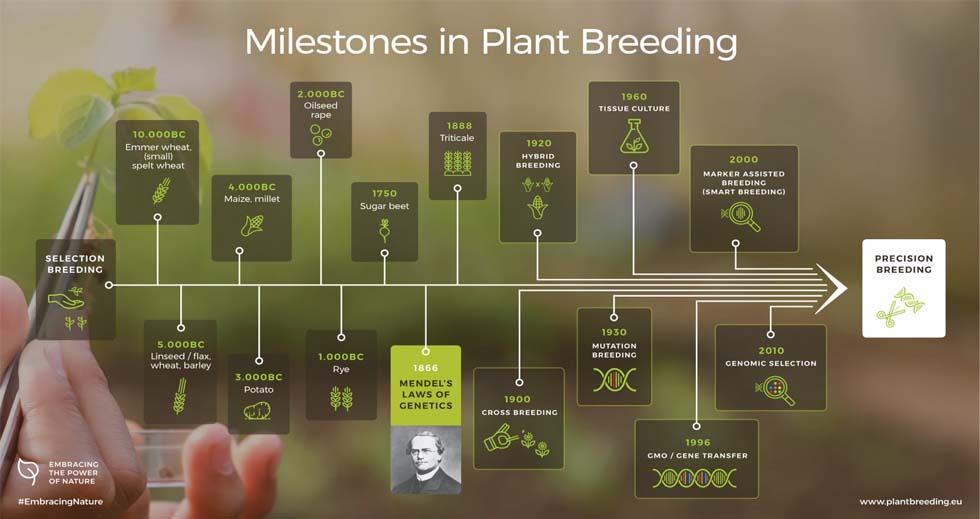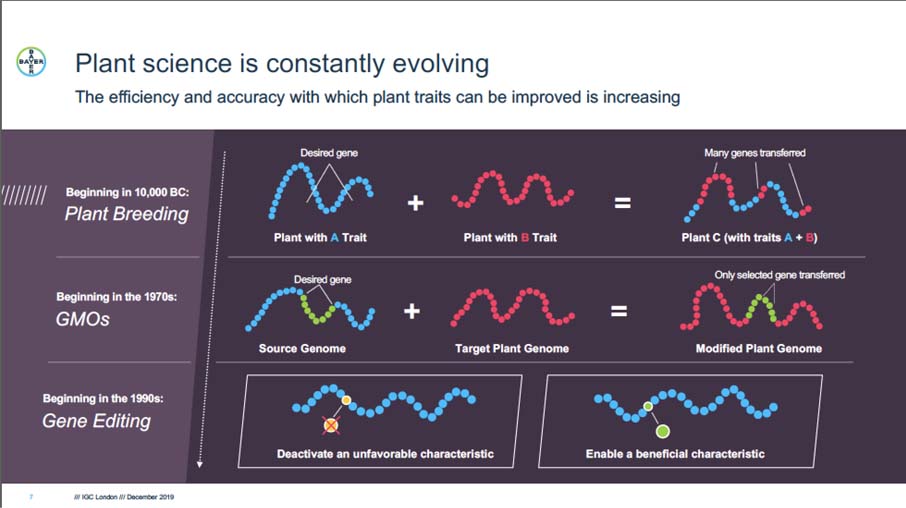Plant Breeding
Plant breeding has occurred for millennia, with significant developments along the way. This varies from the creation of entire crops that we are familiar with today (such as maize, and rye) to varietal advancements, such as improving resistance to diseases in wheat.

Detailed descriptions of the breeding methods are available elsewhere, but this infographic from Bayer gives an indication of how targeted the latest techniques around gene editing can be.

A variety of terms are being used to cover the array of breeding approaches that are possible today. These include precision breeding, new plant breeding techniques (NPBTs) and plant breeding innovations (PBIs). The term currently used by the European Commission is new genomic techniques (NGTs). The definition being used for NGTs is ‘techniques that are capable of altering the genetic material of an organism and which have emerged or have been developed since 2001’.
Situation in the EU
Under certain conditions, plant breeding through mutagenesis has been exempt from the GMO Directive of 2001. Since that time however, new breeding techniques have been developed, including in the field of mutagenesis.
In July 2018 the European Court of Justice ruled that products from new mutagenesis techniques will be subject to the obligations laid down by the GMO Directive of 2001, such as assessment prior to marketing, and traceability. Organisms obtained by mutagenesis techniques which have conventionally been used in a number of applications and have a long safety record continue to be exempt from the obligations.
Globally however, research and practical application of new techniques continues. Planning for this is creating complexity for the food chain because products from these technologies are to be considered conventionally bred in many countries, whereas the EU would consider them to be GM. Global traceability and lack of regulatory coherence is therefore a challenge.
The Commission recognises this, and a response has launched a survey on NGTs. It has until 30th April 2021 to complete a study on the options to update existing EU legislation.
Traceability
The new methods available are much faster than conventional breeding, and also far less expensive. This has meant it is viable for smaller companies, presenting opportunities for plant breeders globally.
Because they do not involve the insertion of foreign DNA (like GM) and are broadly what could be done through conventional breeding or found naturally, tracing what products came from gene-editing techniques is deeply challenging and information intensive, and in many cases is not possible.
The lack of a harmonised regulatory framework presents significant challenges to trade, as there are significant differences in how different countries perceive products of these techniques. The burden of traceability is significant. With much of the international grain trade involving moving product into ever bigger containers (e.g. from a small truck at harvest, through to large ships for international movement) any uncertainty around what is permitted where is a problem.
Examples
Examples of crops under development include a non-browning mushroom (therefore less food waste), powdery mildew resistant wheat (therefore less fungicide use, and reduced yield loss), and wheat resistant to ear germination if it rains before harvest.
The most high profile example available on the market today is the gene-edited high oleic acid soybean in the US from Calyxt.
Calyxt case study
Launched in 2018, the Calyxt Calyno™ soybean is being grown in the USA, and the soybean oil is already used in fast food restaurants across the country. The benefits to both food producers and consumers are numerous, including its high oleic acid content, but also a neutral taste so it does not impact food flavour, its high stability and smoke point, and lower saturated fatty acids than other soybean oil. By February 2020 Calyxt had expanded to contract the milestone 100,000 acres for its gene-edited high oleic soybeans, which it then buys back from growers, crushes, and distributes the oil to fast-food restaurants. High Oleic Soybean Meal is marketed in the US as a premium non-GMO feed ingredient. Whilst a tiny proportion of the total approximately 85 million acres of US grown soya, this is a substantial area for such a short time. Calyxt are also working on a number of other crops, with gene-edited high fibre wheat due to come to market around 2022.
Further information
In 2020 the Genetic Literacy Project launched its free Global Gene Editing Regulations Tracker. This compares the regulatory status and degree of restriction on gene editing techniques and products in different countries around the world. It is a useful resource, with further articles available on what is happening in this fast evolving area.

